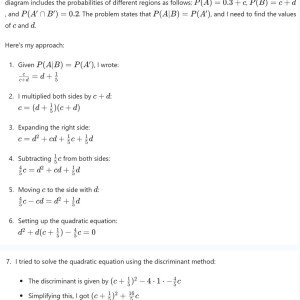Basic Venn diagram probablility.
I'm taking A level mathematics and futher mathematics, but I'm struggling a little when it comes to probability. I ended up solving the question in the images, but I am unsure why my convoluted first method didn't work. So my question is why didn't my original mehtod work? The question and my original workiare provided in the image.
 Mathgnome
Mathgnome
Answer
- The questioner was satisfied with and accepted the answer, or
- The answer was evaluated as being 100% correct by the judge.
 Mathe
Mathe
-
Firstly, how did I complete the square wrong? (c + 1/5)^2 + (16/5)c -> c^2 + (2/5)c + 1/25 + (16/5)c -> c^2 + (18/5)c + 1/25 -> (c + 9/5)^2 + 1/25 - 81/25 -> c^2 + (18/5)c - 16/5. Lastly , I was assuming that the question only had one solution (which I now realise was somethign that I should never do) so I thought that the discriminent in that case would be zero which would allow you to solve for the two unknowns.
-
1/25 - 81/25 = -80/25 but you wrote down something else.
-
I didn't mean to accept the answer. Could you repley to a few of my message? I will tip 5$.
-
Sure, I will reply. Go ahead.
-
I see now that -80/25 = - 16/5, so that was actually correct!
-
-
Thanks for the clarification I thought I was going crazy. So when you said that you can't solve for two unkowns with a single equation I do know that, but I thought the question was saying that there was only one solution for each (which there is), so surely creating a quadratic equation and setting the discriminent equal to zero would mean that it only has one root and therefore only one answer. So, my question is why didn't it work.
-
You could have one root to the quadratic equation where both c and d are positive (true solution) and another root to the quadratic equation were both c and d are negative (not real solutions). This is probably the case. You could replace the values ofc and d that you found on the quadratic equation and see that they must achieve a zero.
-
-
Okay thanks so much that really clears it up for me. I not sure why, but for some reason I was thinking that because there was only one solution to the question I was thinking that if I manipulated it as shown in the images to a quadratic equation the quadratic equation would only have one solution because the question only had one solution.
-
There are very, very few cases where you can solve two unknowns with only one equation.
-
- answered
- 1196 views
- $10.00
Related Questions
- Calculating the Probability of a Varied Selection in Pet Shop Purchases
- Please check if my answers are correct - statistic, probability
- Statistics and Probability
- What is the probability that the last person to board an airplane gets to sit in their assigned seat?
- Car accidents and the Poisson distribution
- Bayesian statistics
- Probability - what is the probability that a given tire length will lie in a lenght of interest
- Existence of a Non-negative Integrable Random Variable with Supremum-Constrained Survival Function


Would you consider increasing the bounty? $5 is very little for our time.
No problem.